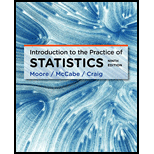
(a)
To find: The variables IBI and area using numerical method.
(a)
Answer to Problem 48E
Solution: The obtained result can be shown in tabular form as follows:
Variable |
Mean |
Standard deviation |
Area |
28.29 |
17.71 |
IBI |
65.94 |
18.28 |
Explanation of Solution
Calculation: Calculate the average and standard deviation of IBI and area using Minitab as follows:
Step 1: Enter the data in Minitab.
Step 2: Click on Stat --> Basic statistics --> Display
Step 3: Double click on “Area” and “IBI” to move it to variables column.
Step 4: Click on “Statistics” and check the box for mean and standard deviation.
Step 5: Click “OK” twice to obtain the result.
Results are obtained as
Variable |
Mean |
Standard deviation |
Area |
28.29 |
17.71 |
IBI |
65.94 |
18.28 |
To find: The variables IBI and area using graphical method.
Answer to Problem 48E
Solution: The graph of “Area” is slightly right skewed and the graph of “IBI” is left skewed.
Explanation of Solution
Graph: Construct the histograms to check the skewness using Minitab as follows:
Step 1: Go to Graphs > Histogram > Simple histogram.
Step 2: Double click on “Area” and “IBI” to move it to variables column.
Step 3: Click “OK” to obtain the result.
The graph is obtained as
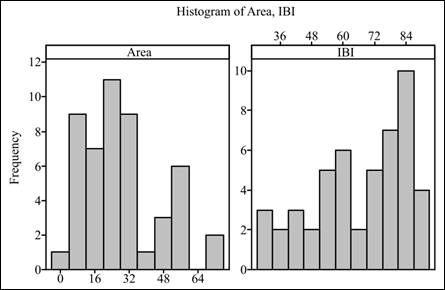
Interpretation: The graph of area is slightly right skewed and the graph of IBI is left skewed.
(b)
To graph: A
(b)
Explanation of Solution
Graph: Construct a scatter plot as follows:
Step 1: Enter the data in Minitab.
Step 2: Click on Graph --> Scatterplot. Select scatterplot with regression.
Step 3: Double click on “IBI” to move it Y variable and “Area” to move it to X variable column.
Step 4: Click “OK” twice to obtain the graph.
The scatter plot is obtained as
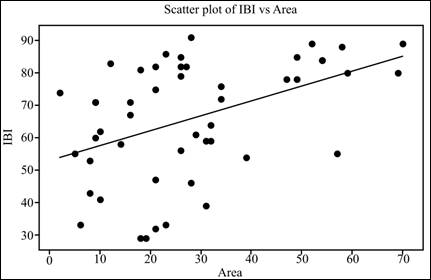
Interpretation: The graph shows weak linear relationship between IBI and Area with no unusual activity.
(c)
To explain: The statistical model for simple linear regression.
(c)
Answer to Problem 48E
Solution: The model is
Explanation of Solution
where
(d)
To explain: The null and alternate hypotheses.
(d)
Answer to Problem 48E
Solution: The null and alternative hypotheses are
Explanation of Solution
So, the null and alternative hypotheses can be stated as
(e)
To test: The least square
(e)
Answer to Problem 48E
Solution: The obtained output represents that the P-value is less than 0.05. So there is enough evidence for the linearity in the regression line.
Explanation of Solution
Calculation: Obtain the regression line using Minitab as follows:
Step 1: Enter the data in Minitab.
Step 2: Click on Stat --> Regression --> Regression.
Step 3: Double click on “IBI” to move it response column and “Area” to move it to predictor column.
Step 4: Click “OK” to obtain the result.
The results are obtained.
Conclusion: From the obtained output, the value of test statistic is 3.42 and the P-value is 0.001. Since the P-value is less than the significance level 0.05, it can be concluded that there is enough evidence for the linearity in the regression line.
(f)
To find: The residuals.
(f)
Answer to Problem 48E
Solution: The residuals are as follows:
Area |
IBI |
Residuals |
21 |
47 |
–15.5862 |
34 |
76 |
7.4318 |
6 |
33 |
–22.6839 |
47 |
78 |
3.4497 |
10 |
62 |
4.4755 |
49 |
78 |
2.5294 |
23 |
33 |
–30.5065 |
32 |
64 |
–3.6479 |
12 |
83 |
24.5552 |
16 |
67 |
6.7146 |
29 |
61 |
–5.2675 |
49 |
85 |
9.5294 |
28 |
46 |
–19.8073 |
8 |
53 |
–3.6042 |
57 |
55 |
–24.1518 |
9 |
71 |
13.9356 |
31 |
59 |
–8.1878 |
10 |
41 |
–16.5245 |
21 |
82 |
19.4138 |
26 |
56 |
–8.8870 |
31 |
39 |
–28.1878 |
52 |
89 |
12.1490 |
21 |
32 |
–30.5862 |
8 |
43 |
–13.6042 |
18 |
29 |
–32.2058 |
5 |
55 |
–0.2237 |
18 |
81 |
19.7942 |
26 |
82 |
17.1130 |
27 |
82 |
16.6529 |
26 |
85 |
20.1130 |
32 |
59 |
–8.6479 |
2 |
74 |
20.1567 |
59 |
80 |
–0.0721 |
58 |
88 |
8.3880 |
19 |
29 |
–32.6659 |
14 |
58 |
–1.3651 |
16 |
71 |
10.7146 |
9 |
60 |
2.9356 |
23 |
86 |
22.4935 |
28 |
91 |
25.1927 |
34 |
72 |
3.4318 |
70 |
89 |
3.8662 |
69 |
80 |
–4.6737 |
54 |
84 |
6.2287 |
39 |
54 |
–16.8690 |
9 |
71 |
13.9356 |
21 |
75 |
12.4138 |
54 |
84 |
6.2287 |
26 |
79 |
14.1130 |
Explanation of Solution
Calculation: Obtain the regression line using Minitab as follows:
Step 1: Enter the data in Minitab.
Step 2: Click on Stat --> Regression --> Regression.
Step 3: Double click on “IBI” to move it to response column and “Area” to move it to predictor column.
Step 4: Click on “Storage” and check the box for residuals.
Step 5: Click “OK” twice to obtain the result.
To graph: The scatterplot.
Explanation of Solution
Graph: Construct a scatterplot using Minitab as follows:
Step 1: Enter the data in Minitab.
Step 2: Click on Graph --> Scatterplot. Select scatterplot with regression.
Step 3: Double click on “Area” to move it X variable and “Residuals” to move it to Y variable column.
Step 4: Click “OK” to obtain the graph.
The scatter plot is obtained as
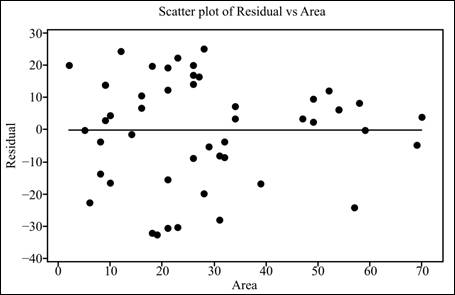
Interpretation: The graph shows that there is more variation for small
Whether there is something unusual.
Answer to Problem 48E
Solution: No, there is nothing unusual.
Explanation of Solution
(g)
That residuals are normal or not.
(g)
Answer to Problem 48E
Solution: The residuals are
Explanation of Solution
Step 1: Click on Stat --> Descriptive statistics --> Normality test.
Step 2: Double click on “Residuals” to move it to the variable column.
Step 3: Click “OK” to obtain the graph.
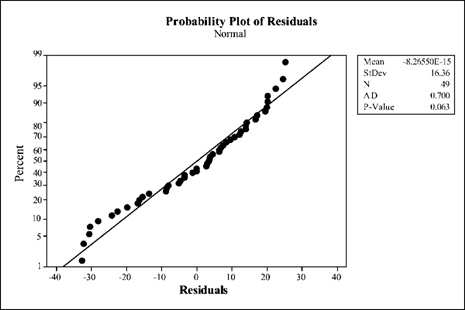
Conclusion: All the points lie near the trend line and there are no outliers. Therefore, it can be concluded that residuals are normally distributed.
(h)
If the assumptions of statistical inference are satisfied or not.
(h)
Answer to Problem 48E
Solution: The assumptions are satisfied.
Explanation of Solution
Want to see more full solutions like this?
Chapter 10 Solutions
Introduction to the Practice of Statistics
- Business discussarrow_forwardBusiness discussarrow_forwardI just need to know why this is wrong below: What is the test statistic W? W=5 (incorrect) and What is the p-value of this test? (p-value < 0.001-- incorrect) Use the Wilcoxon signed rank test to test the hypothesis that the median number of pages in the statistics books in the library from which the sample was taken is 400. A sample of 12 statistics books have the following numbers of pages pages 127 217 486 132 397 297 396 327 292 256 358 272 What is the sum of the negative ranks (W-)? 75 What is the sum of the positive ranks (W+)? 5What type of test is this? two tailedWhat is the test statistic W? 5 These are the critical values for a 1-tailed Wilcoxon Signed Rank test for n=12 Alpha Level 0.001 0.005 0.01 0.025 0.05 0.1 0.2 Critical Value 75 70 68 64 60 56 50 What is the p-value for this test? p-value < 0.001arrow_forward
- ons 12. A sociologist hypothesizes that the crime rate is higher in areas with higher poverty rate and lower median income. She col- lects data on the crime rate (crimes per 100,000 residents), the poverty rate (in %), and the median income (in $1,000s) from 41 New England cities. A portion of the regression results is shown in the following table. Standard Coefficients error t stat p-value Intercept -301.62 549.71 -0.55 0.5864 Poverty 53.16 14.22 3.74 0.0006 Income 4.95 8.26 0.60 0.5526 a. b. Are the signs as expected on the slope coefficients? Predict the crime rate in an area with a poverty rate of 20% and a median income of $50,000. 3. Using data from 50 workarrow_forward2. The owner of several used-car dealerships believes that the selling price of a used car can best be predicted using the car's age. He uses data on the recent selling price (in $) and age of 20 used sedans to estimate Price = Po + B₁Age + ε. A portion of the regression results is shown in the accompanying table. Standard Coefficients Intercept 21187.94 Error 733.42 t Stat p-value 28.89 1.56E-16 Age -1208.25 128.95 -9.37 2.41E-08 a. What is the estimate for B₁? Interpret this value. b. What is the sample regression equation? C. Predict the selling price of a 5-year-old sedan.arrow_forwardian income of $50,000. erty rate of 13. Using data from 50 workers, a researcher estimates Wage = Bo+B,Education + B₂Experience + B3Age+e, where Wage is the hourly wage rate and Education, Experience, and Age are the years of higher education, the years of experience, and the age of the worker, respectively. A portion of the regression results is shown in the following table. ni ogolloo bash 1 Standard Coefficients error t stat p-value Intercept 7.87 4.09 1.93 0.0603 Education 1.44 0.34 4.24 0.0001 Experience 0.45 0.14 3.16 0.0028 Age -0.01 0.08 -0.14 0.8920 a. Interpret the estimated coefficients for Education and Experience. b. Predict the hourly wage rate for a 30-year-old worker with four years of higher education and three years of experience.arrow_forward
- 1. If a firm spends more on advertising, is it likely to increase sales? Data on annual sales (in $100,000s) and advertising expenditures (in $10,000s) were collected for 20 firms in order to estimate the model Sales = Po + B₁Advertising + ε. A portion of the regression results is shown in the accompanying table. Intercept Advertising Standard Coefficients Error t Stat p-value -7.42 1.46 -5.09 7.66E-05 0.42 0.05 8.70 7.26E-08 a. Interpret the estimated slope coefficient. b. What is the sample regression equation? C. Predict the sales for a firm that spends $500,000 annually on advertising.arrow_forwardCan you help me solve problem 38 with steps im stuck.arrow_forwardHow do the samples hold up to the efficiency test? What percentages of the samples pass or fail the test? What would be the likelihood of having the following specific number of efficiency test failures in the next 300 processors tested? 1 failures, 5 failures, 10 failures and 20 failures.arrow_forward
- The battery temperatures are a major concern for us. Can you analyze and describe the sample data? What are the average and median temperatures? How much variability is there in the temperatures? Is there anything that stands out? Our engineers’ assumption is that the temperature data is normally distributed. If that is the case, what would be the likelihood that the Safety Zone temperature will exceed 5.15 degrees? What is the probability that the Safety Zone temperature will be less than 4.65 degrees? What is the actual percentage of samples that exceed 5.25 degrees or are less than 4.75 degrees? Is the manufacturing process producing units with stable Safety Zone temperatures? Can you check if there are any apparent changes in the temperature pattern? Are there any outliers? A closer look at the Z-scores should help you in this regard.arrow_forwardNeed help pleasearrow_forwardPlease conduct a step by step of these statistical tests on separate sheets of Microsoft Excel. If the calculations in Microsoft Excel are incorrect, the null and alternative hypotheses, as well as the conclusions drawn from them, will be meaningless and will not receive any points. 4. One-Way ANOVA: Analyze the customer satisfaction scores across four different product categories to determine if there is a significant difference in means. (Hints: The null can be about maintaining status-quo or no difference among groups) H0 = H1=arrow_forward
 MATLAB: An Introduction with ApplicationsStatisticsISBN:9781119256830Author:Amos GilatPublisher:John Wiley & Sons Inc
MATLAB: An Introduction with ApplicationsStatisticsISBN:9781119256830Author:Amos GilatPublisher:John Wiley & Sons Inc Probability and Statistics for Engineering and th...StatisticsISBN:9781305251809Author:Jay L. DevorePublisher:Cengage Learning
Probability and Statistics for Engineering and th...StatisticsISBN:9781305251809Author:Jay L. DevorePublisher:Cengage Learning Statistics for The Behavioral Sciences (MindTap C...StatisticsISBN:9781305504912Author:Frederick J Gravetter, Larry B. WallnauPublisher:Cengage Learning
Statistics for The Behavioral Sciences (MindTap C...StatisticsISBN:9781305504912Author:Frederick J Gravetter, Larry B. WallnauPublisher:Cengage Learning Elementary Statistics: Picturing the World (7th E...StatisticsISBN:9780134683416Author:Ron Larson, Betsy FarberPublisher:PEARSON
Elementary Statistics: Picturing the World (7th E...StatisticsISBN:9780134683416Author:Ron Larson, Betsy FarberPublisher:PEARSON The Basic Practice of StatisticsStatisticsISBN:9781319042578Author:David S. Moore, William I. Notz, Michael A. FlignerPublisher:W. H. Freeman
The Basic Practice of StatisticsStatisticsISBN:9781319042578Author:David S. Moore, William I. Notz, Michael A. FlignerPublisher:W. H. Freeman Introduction to the Practice of StatisticsStatisticsISBN:9781319013387Author:David S. Moore, George P. McCabe, Bruce A. CraigPublisher:W. H. Freeman
Introduction to the Practice of StatisticsStatisticsISBN:9781319013387Author:David S. Moore, George P. McCabe, Bruce A. CraigPublisher:W. H. Freeman





